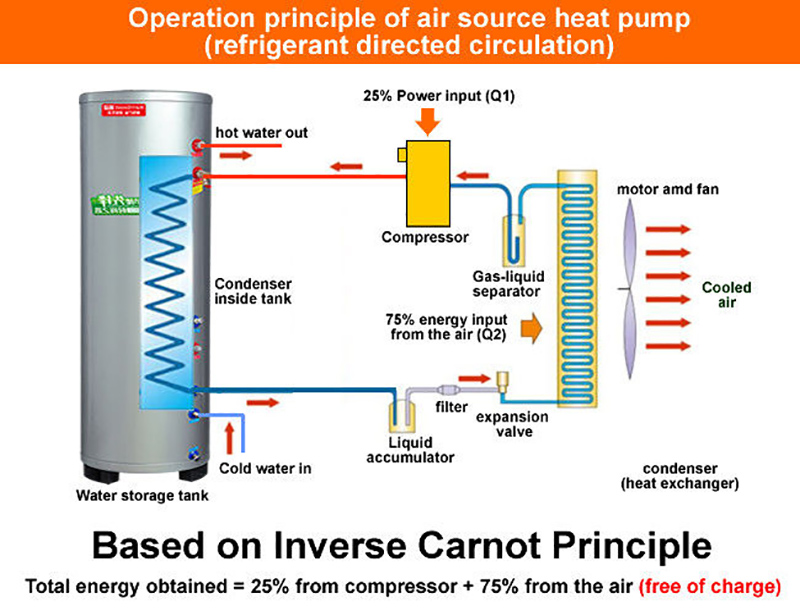At present, there are mainly the following kinds of water heaters in the market: solar water heaters, gas water heaters, electric water heaters and air source heat pump water heater. Among these water heaters, the air source heat pump appeared the latest, but it is also the most popular one in the market at present. Because air source heat pumps do not need to rely on the weather to determine the supply of hot water like solar water heaters, nor do they need to worry about the risk of gas poisoning like using gas water heaters. The air source heat pump absorbs the low-temperature heat in the air, vaporizes the fluorine medium, pressurizes and heats up after being compressed by the compressor, and then converts the feed water to heat through the heat exchanger. Compared with the electric water heater, the air source heat pump produces the same amount of hot water, its efficiency is 4-6 times that of the electric water heater, and its utilization efficiency is high. Therefore, the air source heat pump has been widely recognized by the market since its launch. Today, let’s talk about the installation steps of air source heat pump.
Installation steps of air source heat pump:
Step 1: before unpacking, first check the models of the heat pump units and the water tank to see whether they correspond, then unpack them respectively, and check whether the required parts are complete and whether there are omissions according to the contents of the packing list.
Step 2: heat pump unit installation. Before installing the main unit, it is necessary to install the bracket, mark the punching position on the wall with a marking pen, drive the expansion bolt, hang the assembled bracket, and fix it with a nut. After the bracket is installed, the shock pad can be placed on the four support corners, and then the host can be installed. The standard configuration distance between the host and the water tank is 3M, and there are no other obstructions around.
Step 3: install the refrigerant pipe. Fasten the refrigerant pipe and the temperature sensing probe wire with ties, and separate the refrigerant pipes at both ends in Y-shape, which is convenient for installation. Install the hydraulic base and wrap all interfaces with adhesive tape to prevent water leakage. Connect the pressure relief valve at the hot water outlet and tighten it with a wrench.
Step 4: the refrigerant pipe is connected with the host and the water tank respectively. When the refrigerant pipe is connected with the main engine, unscrew the stop valve nut, connect the flared copper pipe connecting nut with the stop valve, and tighten the nut with a wrench; When the refrigerant pipe is connected with the water tank, connect the flared copper pipe connecting nut with the copper pipe connector of the water tank, and tighten it with a torque wrench. The torque should be uniform to prevent the copper pipe connector of the water tank from deformation or cracking due to excessive torque.
Step 5: install the water tank, connect the hot and cold water pipes and other pipe accessories. The water tank must be installed vertically. The western area of the installation foundation is solid and solid. It is strictly forbidden to hang on the wall for installation; When connecting hot and cold water pipes, raw material tape should be wrapped around the connecting pipe orifice to ensure tightness. Stop valves should be installed at the side of the water inlet pipe and the drain outlet to facilitate cleaning, drainage and maintenance in the future. In order to prevent foreign matters from entering, filters should also be installed at the inlet pipe.
Step 7: install the remote controller and the water tank sensor. When the wire controller is installed outdoors, a protective box needs to be added to prevent exposure to the sun and rain. The wire controller and the strong wire are wired 5cm away. Insert the probe of the temperature sensing bag into the water tank, tighten it with screws and connect the temperature sensing head wire.
Step 8: install the power line, connect the host control line and the power supply, pay attention to the installation must be grounded, connect the refrigerant pipe, tighten the screw with moderate force, connect the water pipe with aluminum-plastic pipe, and the cold water and hot water outlet into the corresponding pipe.
Step 9: unit commissioning. In the process of draining water, the water tank pressure is very high. You can unscrew the pressure relief valve, install the condensate drain pipe on the host, empty the host, open the host control panel, and then connect the switch button to start the machine.
The above is the specific installation steps of the air source heat pump. Because the manufacturer and the model of the water heater are different, you need to combine the actual situation before installing the air source heat pump. If necessary, you should also turn to professional installers.
Post time: Jul-07-2022

